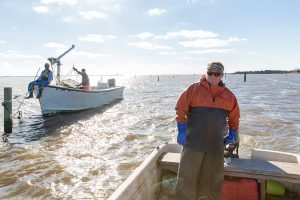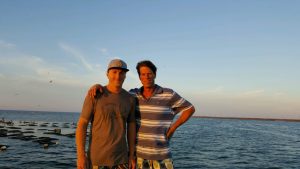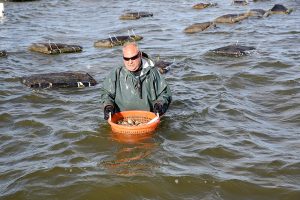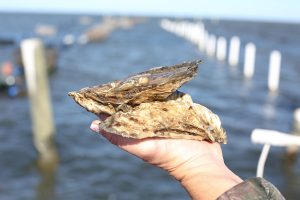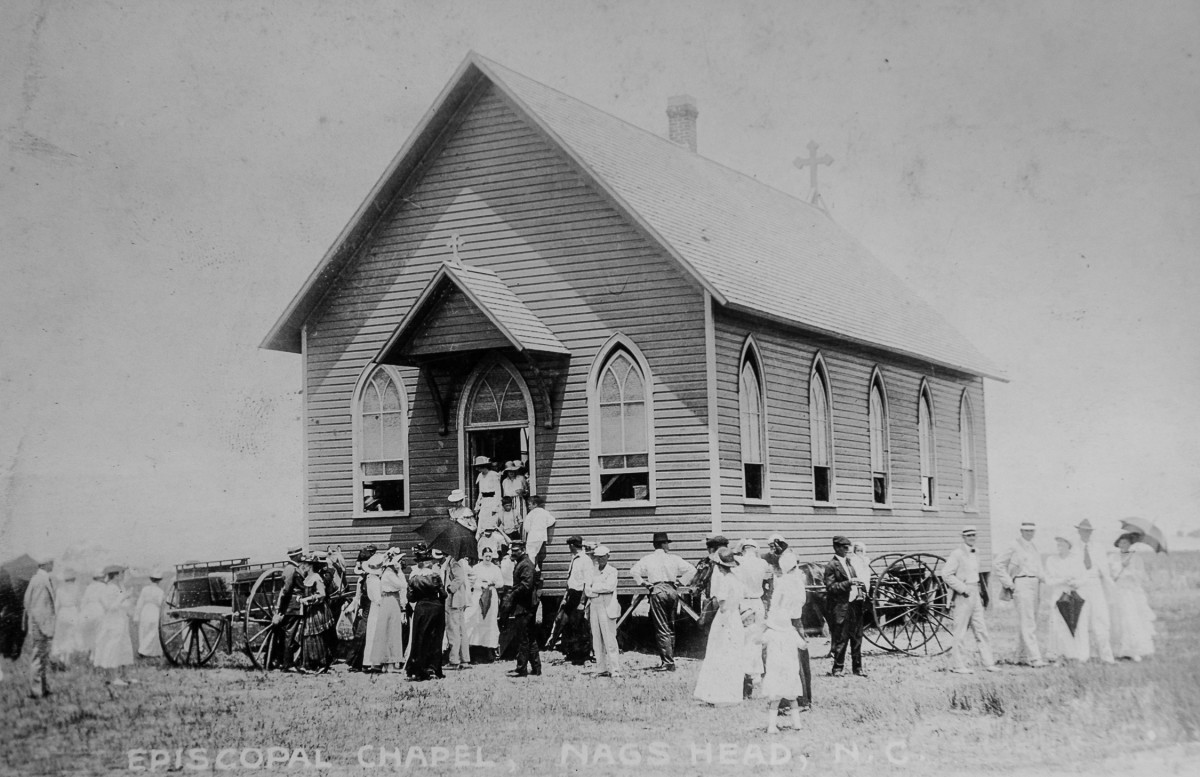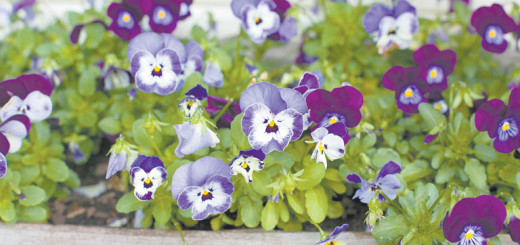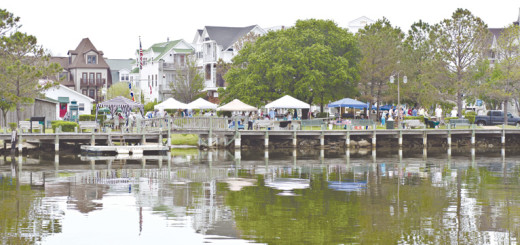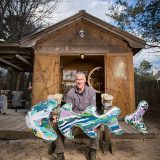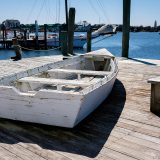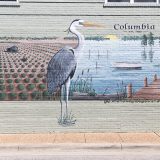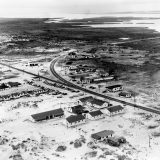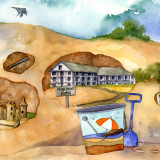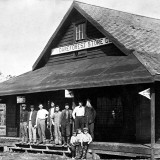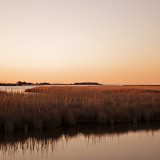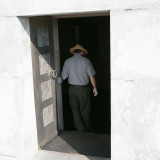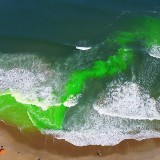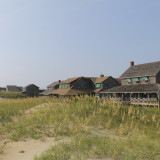The World’s Oyster
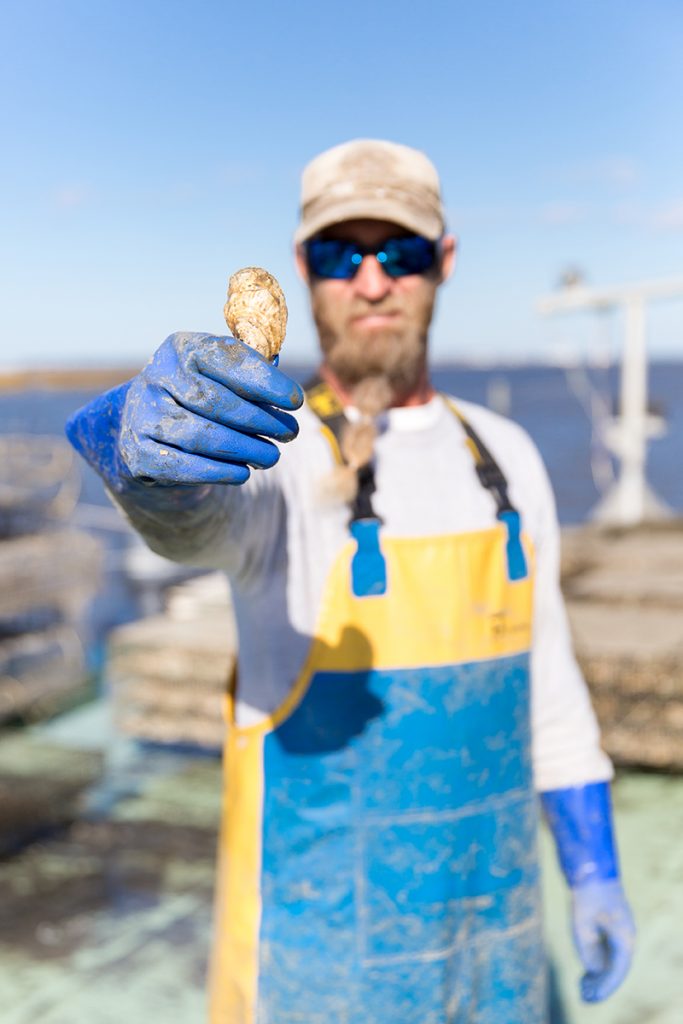
Pat Leonard holds up a locally farmed example of Bodie Island Oysters, Photo by Cory Godwin Productions.
“Why, then the world’s mine oyster,” Shakespeare famously wrote in his play, The Merry Wives of Windsor. “Which I with sword will open.”
It is perhaps one of his most well known quotes (although it isn’t always correctly attributed to him). And plenty of other literary giants have followed in his footsteps by writing — often rapturously — about the joys of oysters. From Jonathon Swift to Jules Verne, Lewis Carroll, Ernest Hemingway and Anne Sexton, many have gone to great lengths to describe such a seemingly simple creature — particularly the exquisite pleasure of consuming them.
But it seems fitting to begin with Shakespeare because over the years the sentiment behind those few simple lines has been reinterpreted to invoke the idea that life is full of nearly endless possibilities and opportunities. And today, more than 400 years after Shakespeare first penned those words, that sense of unlimited potential might be the best way to describe the current state of oyster farming on the Outer Banks.
Changing the Tide
The road to Bodie Island Oysters in Wanchese is literally off the map. Pavement ends and gives way to a winding gravel pathway that’s patched with small mounds of sun-bleached oyster shells. And if you happen to time it just right, that’s where you’ll often find Joey Daniels, the man who’s made a passion for oysters his life’s work.
“You couldn’t have picked a better day,” Joey says as he steers his boat away from the docks and out into the Roanoke Sound. In almost no time his nine-and-a-half-acre oyster lease is in sight. Bordered by the pristine banks of the Cape Hatteras National Seashore and within what almost feels like arm’s reach of Bodie Island Lighthouse, Joey’s open-water lease is also only a short distance from Oregon Inlet — making it prime real estate for oyster cultivation due to the regular influx of fresh saltwater from the ocean and its remote, undeveloped surroundings.
Joey is by no means the first person to see the potential in harvesting North Carolina oysters. Early colonial records indicate that wild oysters were once so plentiful across the whole Eastern Seaboard that many considered them an inexhaustible resource — yet when Virginia and Maryland’s massive oyster beds were virtually depleted by the late 1800s, the industry turned to North Carolina to keep up with demand. According to government records, N.C. oyster harvests peaked at slightly more than 800,000 bushels in 1902. That number steadily declined from there, and even reached a record low of 35,000 bushels in 1994.
But the tide may be changing, and people like Joey are the reason behind it. And that, in short, is because he’s not simply relying on wild oyster populations — he’s raising his own crop of them.
Joey, a fourth-generation waterman, became interested in the concept of oyster farming several years ago. After doing quite a bit of research he became convinced that he could make a go of it, so he pitched the idea to the board members of Wanchese Fish Company, a business his great-grandfather started 80 years ago in 1936.
Once Joey was given the green light, he hit the ground running, and it quickly paid off. About a year and a half after planting his initial oyster seeds, Bodie Island became the first cultivated oysters grown on the Outer Banks. Three years later it’s now one of the biggest oyster producers in the state. At last count they had about 1,200 off-bottom cages out in the water that were collectively holding between three to four million oysters.
“We’ve definitely grown into that,” Joey says with a laugh. “And there’s still plenty of ways to expand. I’d like to see the Outer Banks become known for its oysters. People just need to see that it works.”
While having the backing of Wanchese Fish Company was helpful (the startup costs involved in opening an oyster farm with large-scale distribution can sometimes be prohibitive), Joey is a hugely enthusiastic supporter of several other local entrepreneurs who are starting smaller but also looking forward to a growing future — including Pat Leonard and Bob Howell, two of Joey’s longtime crew members who have already secured and seeded their own lease near Bodie Island and plan to begin harvesting Lost Colony Oysters this coming spring.
And they’re not the only ones. Slightly farther south in Buxton you’ll find Bill and Ryan Belter, the father and son team responsible for Hatteras Salts oysters, which they harvest under the business name Cape Hatteras Oyster Company.
Prior to starting their business, Bill was a contractor in Norfolk, but he had a deep, longstanding connection to this area and the water. After relocating to Hatteras with Ryan in 2010 they began harvesting some wild oysters, and that eventually sparked a mutual interest in pursuing other options.
“Joey was a big mentor for us from the beginning,” Ryan says. “But it still started slowly — it took us three years to get approved for a lease.”
Once their one-acre lease was finally approved in 2014, they didn’t let anything slow them down, and they began distributing their oysters last year both within the state and to locations as far away as Texas, Missouri and New York. And while they still run their entire operation as a two-man team right now, they have every reason to continue thinking bigger and better. They anticipate being approved for an additional four acres by the end of this year, and according to Ryan, that should allow them to at least double their annual yield, which averaged about 200,000 oysters over the course of their first year.
“I’ve pushed myself hard all my life,” Bill says with a good-natured smile as he describes the 90 to 100-hour work weeks the two of them routinely put in, especially during summer months. “I don’t see a vacation in my immediate future, and honestly I’m fine with that.”
That’s a viewpoint that likely resonates with Fletcher O’Neal, the man behind our area’s newest mariculture venture — at least as far as oysters are concerned. Called Devil Shoal Oyster & Clam Company, and located even farther south on Ocracoke Island, Fletcher’s oyster business is actually a joint enterprise with fellow Ocracoke native Arlene Burley who’s already been harvesting clams there for two decades.
“There’s a lot of work to it,” says Fletcher who used to be a commercial fisherman before turning to oyster cultivation. “I’m out there six days a week, sometimes seven, and there’s always something to do.”
Like Joey and the Belters, Fletcher has been experimenting with various oyster-growing techniques that include everything from cages to floating bags and a few other things that lie somewhere in between — such as Fletcher’s personal favorite system of using extra-large off-bottom wire cages that are designed to hold mesh bags within individual vertical compartments.
Unlike the others, Fletcher has only been in the oyster business for little over one year. Last summer he put his first 100,000 seeds (otherwise known as “spats”) in the water, which allowed him to begin officially distributing market-sized oysters about six months ago. But don’t let his relative newcomer status fool you: Fletcher (who’s often assisted by his 12-year-old son, Brandt, on afternoons and weekends) has high expectations for the future, and that includes adding 10 more acres to the original five-acre Devil Shoal lease.
“By this time next year I hope to have a million out there about ready for market,” he says. “I’ll do whatever I can to stay out on the water.”
At the end of the day statewide oyster harvest numbers are still low, but they are slowly starting to rise. (According to the N.C. Division of Marine Fisheries, which continues to list oysters as a “species of concern,” the 2014 N.C. oyster harvest was approximately 137,000 bushels — almost quadrupling the historic 1994 low for the first time in two decades.) A large factor in this upswing can certainly be attributed to this growing interest in oyster farming as a sustainable industry on the Outer Banks and far beyond.
An Ode to Oysters
“Oysters are what we call a keystone species,” says Erin Fleckenstein, North Carolina Coastal Federation’s Northeastern regional manager. “They’re an indicator of water quality, or what we like to call the canaries of the sound.”
The bottom line is that healthy oysters aren’t only important ecologically speaking — they’re vital. Not only do they provide an essential habitat for a number of other aquatic species, but they also do a tremendous job of filtering water (one oyster alone can filter up to 50 gallons of water a day as it feeds on algae or microscopic phytoplankton).
That’s good news, but it also means that they need to be grown and harvested in clean water. Luckily, N.C. is a premier location for that type of water quality, and the Coastal Federation in particular has long championed a wide array of efforts to keep our state waters healthy.
But there’s still plenty of work to be done moving forward. One of the things that’s been holding N.C. back from keeping up with states such as Virginia (where oyster farming has been thriving exponentially over the past decade) is at least partially the fact that the procedure for obtaining a lease in this state has involved a somewhat labyrinthine — and often lengthy — series of bureaucratic hurdles.
“The regulatory process for getting an oyster lease has been pretty cumbersome, so we’re working with state agencies to try and streamline that,” Erin says. “For us it’s a win-win situation to advocate for, and work with, the local farms. It’s a truly green industry that also supports the Outer Banks’ economy and culture.”
The Coastal Federation is even currently going through the lease process themselves as part of a joint initiative with N.C. Sea Grant that’s designed to establish a demonstration lease near its Wanchese offices. The goal for this project is to provide a space where new or aspiring oyster farmers can go to learn more about the different growing techniques and see them put into practice.
Because, ultimately, the prospects for this state’s oyster farm industry are enormous. As of September 2015, only 1,931 acres of water in N.C. were being used for shellfish leasing. As Erin points out, that’s less than one percent of our waters that are capable of supporting shellfish growth — and it’s a far cry from Virginia where about 125,000 acres are now in use. “The numbers in North Carolina are just a drop in the bucket,” Erin says. “But it shows you the potential we have here.”
Chuck Weirich, a marine aquaculture specialist with Sea Grant, agrees. “In 2015 the revenue from farmed oysters in North Carolina was $480,000,” he says. “By comparison, Virginia’s revenue was more than $16 million. Our industry is still in its infancy.”
Farm to Plate
At Coastal Provisions in Southern Shores, chef and owner, Dan Lewis, expertly shucks several different varieties of oysters — from West Coast Kumamotos to Maine’s rare Belons, numerous offerings from the Chesapeake Bay, and, of course, the Outer Banks’ first three homegrown offerings. It’s a pretty typical night at this popular local oyster bar where they routinely serve a wide selection of about 1,500 oysters a week, year round, to residents and visitors alike.
What’s not so typical is the fairly recent shift that restaurants in this area have seen in terms of their ability to serve up local oysters. “Most of what has been available to us in this region has been Virginia’s farmed oysters purely because of how many there are,” Dan explains. “But it’s a great day when more than half of our selection is from North Carolina.”
In an age when there’s increasing concern over sustainable food sources and people are making more of an effort to reduce their ecological footprints, farmed oysters reign supreme — especially when they’re cultivated practically in our backyards. And even if you leave all the facts and figures aside, there’s a value there that goes far beyond economics.
“It’s about community,” Dan says. “It’s about knowing and supporting our local farmers, having a face-to-face relationship with those who are growing our food, and understanding where and how it’s grown.”
That may be especially true with oysters. As James Beard award-winning author Rowan Jacobsen says in his seminal book, A Geography of Oysters, these bivalves in particular have a “somewhereness” to them that’s virtually unmatched by any other delicacy.
“Oysters are creatures of bays and tidal pools and river inlets, of places where marine and terrestrial communities collide. While they are creatures of the sea, they draw their uniqueness from the land and how it affects their home waters,” Rowan writes. “In a mass-produced society where most food doesn’t seem to be from anywhere, this makes them special…. Think of an oyster as a lens, its concave shell focusing everything that is unique about a particular body of water into a morsel of flesh.”
Not everyone loves oysters. But there is, as Rowan also points out, an art to them. From the year (or more) of tending them, to the ritual of opening one and experiencing that first briny taste of the sea that’s so perfectly encapsulated in a single mouthful, it’s not hard to see why so many have gone to such great lengths to describe these creatures — and so many others are now working hard to ensure that they’re widely available for generations to come.
Because ultimately, like oysters, we’re all part of an interconnected web that isn’t easily mapped out or broken. And if the current state of oyster farming on the Outer Banks is any indication, a bright, and potentially limitless, future still lies ahead.


